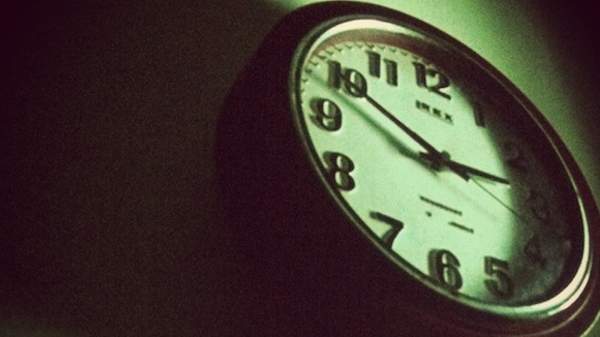Overview
French toast for dinner. Night swimming. Sleeping at noon on a rainy day. Being outside to see the sun rise. Ordinary things become extraordinary when taken out of their standard time and placed in another. Which is why it feels thrilling, at 2am, to be standing at the plaza-like entrance of the renovated and repackaged Museum of Contemporary Art Australia, and for its glass doors to slide open and welcome you in.
The late-night invitation comes courtesy of Christian Marclay's The Clock, which is launching the MCA's new wing as part of the broader exhibition Marking Time. To properly display the acclaimed work — described as "the most staggering, complex thing made by any artist so far this century" by the Guardian's Adrian Searle — the MCA is staying open all through the night each Thursday from March 29 until May 31. Composed of several thousand extracted moments from cinema history, each one evoking a specific time of day by the appearance of a clock face, The Clock builds a 24-hour film that you watch in real-time.
It's odd that just when you feel like you're doing something out of step with time, everything happening on screen is precisely tuned to it. No-one on screen is at the art gallery. Filmmakers have filled this ungodly hour with insomnia, paranoia, itinerancy, underworld plotting and a healthy serve of rooting. I spot James Stewart spying on his neighbours in Rear Window and Phoebe Cates storming aboard Carrie Fisher's houseboat in Drop Dead Fred. I probably definitely fall asleep a little. I wake up very aware of what the time is.
The theatrette's couches are full of die-hard experiential art enthusiasts, some mellow revellers from conveniently located parties and people who got here at a more civilised hour and then fell asleep. Some are here for the long haul; they have blankets. The atmosphere is of a pensive, intellectual sleepover.
It's a good time to be watching The Clock, because it's late at night that we let the unusual and spontaneous into our lives, both on and off screen. Observing the piece in the middle of the day, you see people at their workstations and family dinners, most, like you, busy and negotiating a routine. They relax as day ends. After midnight, anything can happen. By 5am, apparently, only the possibility of surrealist dream sequence remains.
There are a couple of big questions people have about The Clock. The first, always before seeing it, is, can such a work really hold your interest for a prolonged period? The answer is yes. It's astonishing how readily our brains will build a narrative when given only fragments. But the editing techniques Marclay has used facilitate this, as the actions and movements begun in one scene often eerily continue in the next, and the soundtrack spills over with it. Plus, as well as presenting a big, sprawling, multipronged story, The Clock is appropriately hypnotic.
The second big question, the one that comes after seeing it, is how the hell was it all put together? Who watched all these films? What computer rendered 24 hours worth of film? It took the backing of London's White Cube and New York's Paula Cooper gallery, more than US$100,000 and a team of six eager DVD-watchers who could compile a database of clocks and their surrounding scenes. The project took three years. It's an investment that paid off.
Having picked up the Golden Lion for best artist at the 2011 Venice Biennale, The Clock has been attracting record audiences wherever it goes. Fortunately, this is one exhibition where getting in early to beat the crowds is a genuinely fun proposition.
Information
When
Thursday, March 29, 2012 - Sunday, June 3, 2012
Thursday, March 29 - Sunday, June 3, 2012
Where
MCA140 George Street
Sydney
